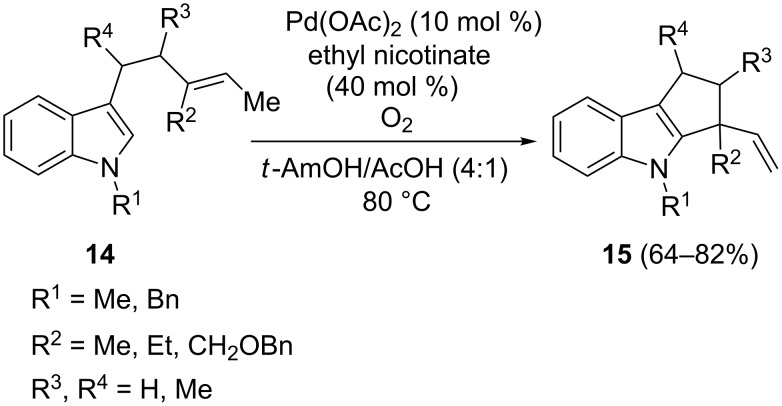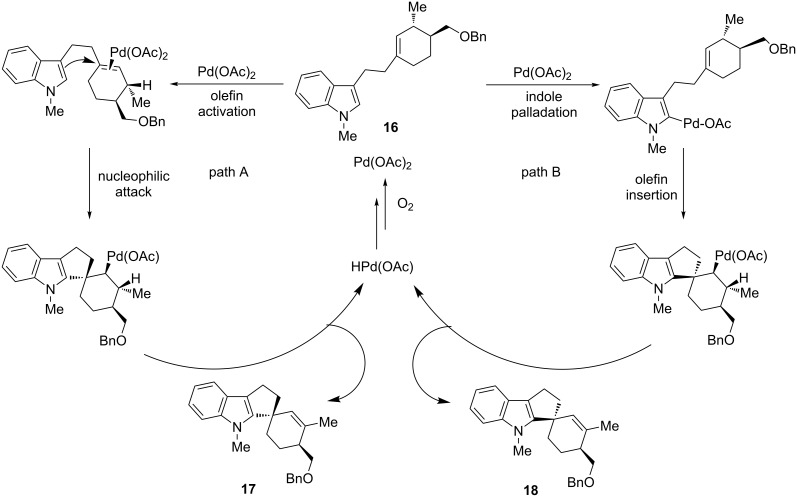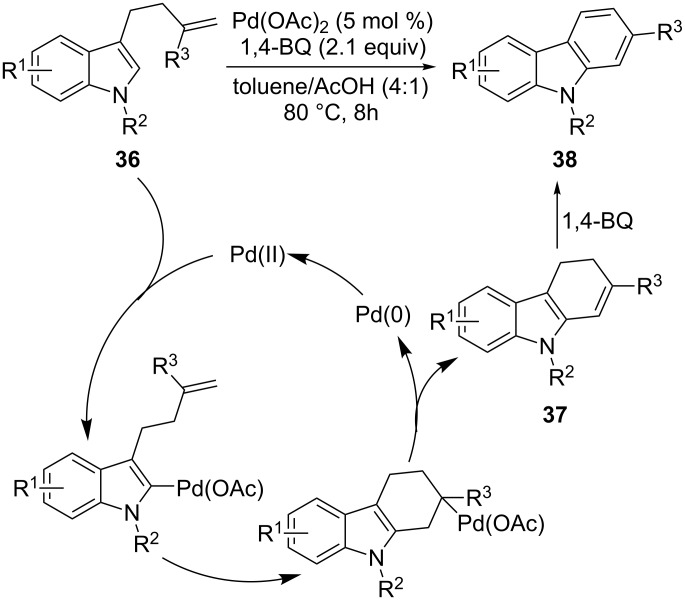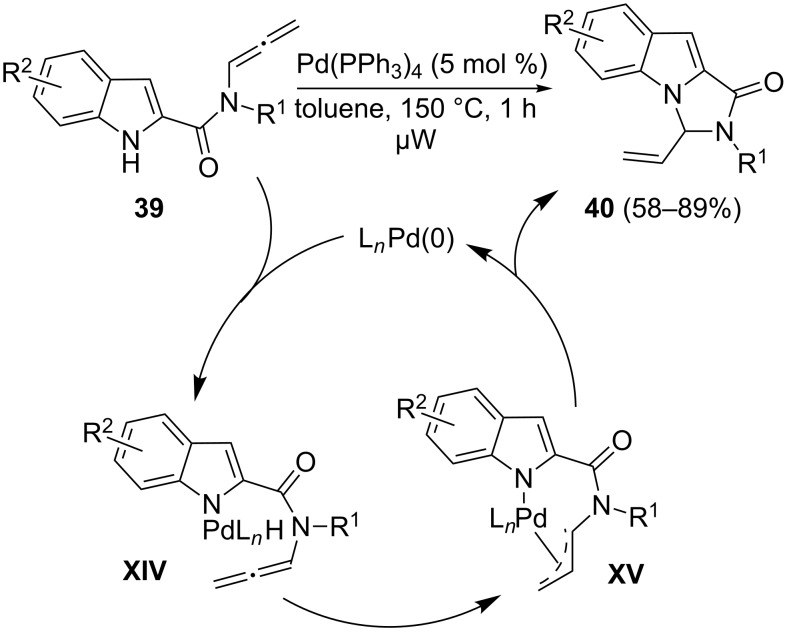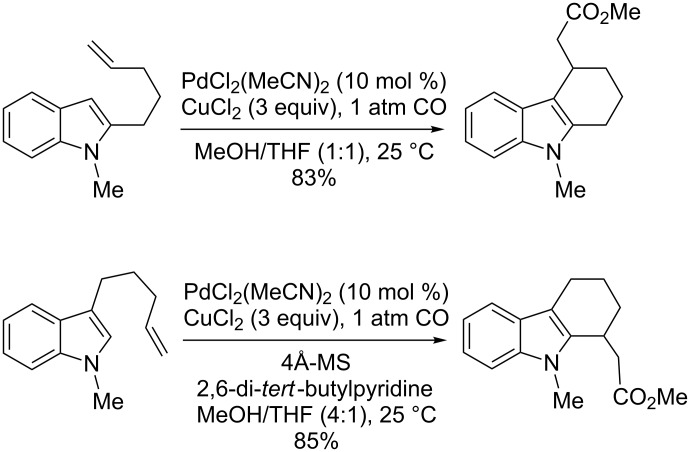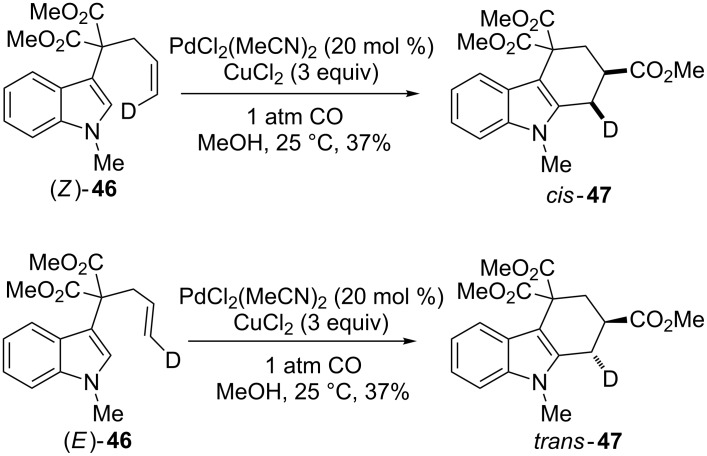Abstract
This review highlights the development of palladium-catalyzed C–H and N–H functionalization reactions involving indole derivatives. These procedures require unactivated starting materials and are respectful of the basic principle of sustainable chemistry tied to atom economy.
Keywords: alkenylation, arylation, C–H functionalization, indoles, N–H functionalization, Pd catalysis
Introduction
The development of mild and selective reactions for the direct conversion of carbon–hydrogen bonds into carbon–carbon and carbon–heteroatom bonds is a challenging goal in organic chemistry [1–3]. The coupling of C–H/C–H or C–H/N–H bonds in an oxidative system is an attractive target since hydrogen or water would be the only formal byproduct. In this field, (hetero)aryl–(hetero)aryl, (hetero)aryl–alkenyl, and (hetero)aryl–alkyl reactions represent some of the most important tools for planning the synthesis of a wide range of different kinds of molecules. Synthetic approaches using unfunctionalized reagents rather than halogenated compounds have attracted strong attention, above all due to their atom- and step-economical characteristics.
Thus, the applicability of these transformations on the multiscale level paves the way to cheaper processes, resulting in minimal waste production and raising the possibility of application in multistep synthetic sequences. Many transition metals, including Pd, Au, Ru, Rh, Cu, and Pt, have been proven to be highly efficient for the formation of new bonds without prefunctionalized starting materials [4–10]. Among the transition metals suitable for this purpose, palladium plays a pivotal role due to its versatility in different synthetic protocols and tolerance towards many functional groups, often avoiding the need for protecting-group chemistry [11–16]. Moreover, palladium-catalyzed reactions involving ethylenic double bonds can also lead to domino processes such as carboaminations [17–19], diaminations [20–21], aminooxygenations [22–23], and aminohalogenations [24–25]. The most common reactions of C–H functionalization on unactivated substrates typically occur with electrophilic Pd(II) catalysts and require an oxidizing agent in order to make possible the reoxidation of the Pd(0) species, generated in the final elimination step, for a new catalytic cycle [12–15].
The well-established features of natural or man-made compounds containing an indole backbone are of wide interest in pharmacological and agrochemical fields [26–28]. Thus, indole and carbazole nuclei are used in medicine for their antibacterial, antimicrobial, and anti-inflammatory effects and occupy a relevant role in the discovery of active antitumor drugs [29–31]. Carbazole derivatives also find applications in organic materials as chromophores and photoconductors [32]. For several years, the development of methodologies concerning indole synthesis and functionalization has been one of the most attractive goals in organic chemistry [33–39]. In the search for clean and sustainable synthetic protocols suitable to construct and convert the indole core motif into more complex structures, palladium-based catalytic systems were proven to be fruitful tools for organic chemists [40–42].
This review highlights methodologies based on the use of palladium catalysts, devoted to the functionalization of indole derivatives involving carbon–hydrogen and nitrogen–hydrogen bonds. The synthetic procedures are classified as intermolecular and intramolecular alkenylations, arylations, and domino processes.
Review
Intermolecular reactions involving alkenes
Alkenylation reactions of indoles run through a key C–H activation step involving an electrophilic palladation and an electron-deficient Pd(II) catalyst. The mechanism of these reactions involves the generation of a σ-alkyl complex I, which is the rate-determining step of the reaction, and conversion into the alkenylindole by a syn-β-hydride elimination process (Scheme 1) [43–45]. Beside the formation of the final product, the last step results in the elimination of HX and Pd(0) species, justifying the need for an oxidant agent to regenerate a Pd(II) species as active catalyst. Although seldom unambiguously determined, two alternative pathways, based either on “alkene activation” or “indole activation”, have been proposed to explain the formation of the σ-alkyl complex I. The former involves the coordination of the Pd(II) catalyst to the olefin, giving the π-olefin complex II, which is converted by nucleophilic attack of the indole into the intermediate I. On the other hand, an electrophilic attack of the Pd(II) catalyst on the indole to generate the indolyl-palladium(II) complex III, in turn susceptible to attack by the olefin, may be hypothesized as a plausible way to form the σ-alkyl complex I. In both pathways, indole may be involved directly at the C-2 or C-3 positions as well as preferentially at the C-3 position, in the latter case affording the final 2-substituted product by the intrinsic tendency toward C-3/C-2 rearrangement that is operative during the alkylation of indoles [46].
Scheme 1.
Typical catalytic cycle for Pd(II)-catalyzed alkenylation of indoles.
In 1969, Fujiwara and Moritani reported the alkenylation of arenes catalyzed by Pd(OAc)2, using Cu(OAc)2 or AgOAc as oxidants [47]. This strategy provides a convenient method for the synthesis of olefins linked to heteroarenes, including indole, furan, and benzofuran rings (Scheme 2) [48]. Working with indole and methyl acrylates in the presence of Pd(OAc)2 and 1,4-benzoquinone in catalytic quantity with tert-butyl hydroperoxide as oxidant, 3-alkenyl-substituted products were obtained.
Scheme 2.
Application of Fujiwara’s reaction to electron-rich heterocycles.
The synthetic value of the direct catalytic C–H alkenylation of the C-2 and C-3 positions of the unprotected indole nucleus was recognized under different conditions published several years ago. In 2005, Gaunt and co-workers disclosed a general method for the selective intermolecular alkenylation of the unprotected indoles through an oxidative palladium-catalyzed reaction (Scheme 3) [49]. The reaction can involve the formation of carbon–carbon or carbon–nitrogen bonds, which is strongly dependent on the solvent used. When the reaction is carried out in aprotic polar solvents, such as DMSO and DMF, with Cu(OAc)2 as reoxidizing agent, the alkenylation occurs at the 3-indolyl position, yielding products 1. Conversely, the use of dioxane with the addition of acetic acid as a polar coordinating co-solvent in the presence of tert-butyl benzoyl peroxide, directs the selectivity in favor of the C-2 substituted indoles 2. It should be noted that the same chemistry has been successfully extended to the pyrrole ring [50].
Scheme 3.
Regioselective alkenylation of the unprotected indole.
A rational explanation for the outcome of these reactions is described in Scheme 4. In both cases, intermediate IV is involved as the result of a direct palladation at the C-3 position. Working under neutral conditions, a proton can be easily removed from IV by the anion formed from the initial palladium salt with generation of the 3-indolyl-palladium complex V, which evolves a Heck-type reaction to give the 3-alkenylindoles 1. Conversely, the deprotonation of the C-3 position is difficult in acidic medium, favoring the transfer of metal species to the 2-indolyl carbon of IV, activated as an iminium carbon. The so-formed intermediate VI undergoes loss of HX with generation of the complex VII, which finally reacts with alkenes giving the 2-alkenylindoles 2 and a Pd(0) species.
Scheme 4.
Plausible mechanism of the selective indole alkenylation, adapted from [49].
An alternative approach to address the regioselective alkenylation of the C-2 position is based on the directing control of a group attached to the indole nitrogen. Under the same conditions, i.e., PdCl2 as catalyst and Cu(OAc)2 as oxidant in acetonitrile at 60 °C, alkenylation of N-benzyl-protected indole 3 took place selectively at the C-3 position, while the reaction of the N-(2-pyridylmethyl)-substituted indole 4 resulted in the functionalization of the C-2 position by directing coordination to the pyridyl nitrogen (Scheme 5) [51].
Scheme 5.
Directing-group control in intermolecular indole alkenylation.
The control of the regioselectivity in the Pd(II)-catalyzed C–H alkenylations towards the indole C-2 position can be exerted by the N-(2-pyridyl)sulfonyl group, which can be easily installed and removed [52–53]. The reaction of 5 with a wide range of mono-, 1,1- and 1,2-disubstituted alkenes in the presence of a catalytic system based on PdCl2(MeCN)2 (10 mol %) and Cu(OAc)2 (1 equiv) in DMA, furnishes the product 6 in moderate to good yield (Scheme 6). A mechanism including an electrophilic palladation involving the pyridinyl chelation was thought to be plausible taking into account the outcome of the reaction performed on isotopically labeled substrates as well as by kinetic studies of variously substituted indoles. This N-(2-pyridyl)sulfonyl-directing strategy has also been extended to the development of a protocol for the intermolecular, dehydrogenative homocoupling of indole, providing 2,2’-bisindoles 7.
Scheme 6.
Direct C–H alkenylation of N-(2-pyridyl)sulfonylindole.
Intermolecular Pd(II)-catalyzed N–H functionalization has also been successfully used to achieve N-substituted indoles. Coupling of indole and 2-methyl-2-butene in the presence of Pd(OAc)2 (40 mol %), Cu(OAc)2 and AgOTf as the co-oxidants in MeCN constitutes a simple route to N-prenylated indoles 8 (Scheme 7) [54]. This mild reaction, which exhibits broad functional-group tolerance, can be successfully performed for the prenylation of tryptophan and tryptamine derivatives, as well as peptides containing tryptophan.
Scheme 7.
N-Prenylation of indoles with 2-methyl-2-butene.
Taking into account some experimental evidence obtained from the use of 2-methyl or 2-deuterium-substituted indoles and from [1,1,1-D3]3-methyl-2-butene, the mechanism shown in Scheme 8 was thought to explain the outcome of the reaction. Firstly, Pd(II) catalyst promotes the formation of the π-allyl-palladium complex VIII, which can evolve by coordination of the N-1 or C-3 positions of the indole nucleus giving the palladium complexes IX and X, respectively. The latter quickly converts into the σ-alkyl-palladium intermediate XI by a Claisen-type rearrangement that involves the metal species. A mechanism through the typical π-olefin-palladium complex as the precursor of the σ-alkyl-palladium complex XI cannot, however, be ruled out. In every case, a Pd(0) species was released from XI and reoxidized with the Ag(I) and Cu(II) salts.
Scheme 8.
Proposed mechanism of the N-indolyl prenylation.
Intermolecular reactions involving arenes
The formation of homo-coupling products is one of the most common drawbacks in intermolecular reactions between arenes without preactivation of the substrates. In 2006, Lu and co-workers reported one of the first articles providing conditions to access asymmetric biaryl compounds by dual C–H functionalization [55].
In 2007, Fagnou and co-workers combined, in a single catalytic cycle, the reactivity of electron-deficient palladium(II) complexes with electron-rich arenes (through an electrophilic C–H activation mechanism) and the reactivity of some Ar-Pd(II) complexes with arenes (through a proton-transfer palladation mechanism), depending on the C–H acidity rather than the arene nucleophilicity. Synthetic procedures based on this strategy allowed the direct arylation at C-2 and C-3 positions of indoles 9 with a high degree of regioselectivity (Scheme 9) [56–57]. 3-Arylindoles 10 were selectively achieved on N-acylindoles by using catalytic Pd(TFA)2 and a stoichiometric amount of Cu(OAc)2. The use of additives, such as 3-nitropyridine and caesium pivalate, was proven essential to achieve optimized conditions.
Scheme 9.
Regioselective arylation of indoles by dual C–H functionalization.
It is plausible that the presence of pyridine can stabilize the final Pd(0) species favoring its reoxidation and avoiding the precipitation of palladium black. The use of AgOAc as oxidant induces an inversion of selectivity, improving the C-2 arylation process. A high level of C-2 selectivity was achieved by using the N-pivalyl-substituted indole in the absence of additives. From the mechanistic point of view, as depicted in Scheme 10, the C–H activation on the electron-rich indole, selectively directed by the strongly electrophilic behavior of the Pd(TFA)2 catalyst, is plausible giving the Pd(II) intermediate XII. The subsequent selective coordination of the arene generates the complex XIII, which in turn undergoes reductive elimination providing the final product and a Pd(0) species. The reoxidation of the latter giving the active Pd(II) catalyst completes the catalytic cycle.
Scheme 10.
Plausible mechanism of the selective indole arylation.
In addition to the effect of Cu(OAc)2 and AgOAc as oxidant, a determinant role on the selectivity of direct C–H to C–H cross-coupling reactions was played by the acidity of the medium, as shown by reactions carried out in the presence of AcOH [58–59]. Based on experimental and computational data, a concerted metalation–deprotonation of the arene was hypothesized to explain the mechanism for C–H palladation.
Intramolecular reactions involving alkenes
The first example of intramolecular indole alkenylation was reported in 1978 by Trost, who applied reaction conditions based on stoichiometric amounts of PdCl2(MeCN)2 and silver ions in the key step of the total synthesis of ibogamine alkaloids [60].
Palladium-catalyzed cyclization of N-allyl-1H-indole-2-carboxamides 11 is a fruitful procedure to access β-carbolinones 12 or pyrazino[1,2-a]indoles 13 (Scheme 11) [61–62]. The use of PdCl2(MeCN)2 as the catalyst with 1,4-benzoquinone as the oxidant in a mixture of DMF/THF resulted in the C-3 functionalization of the indole nucleus. Conversely, switching to Pd(OAc)2 with Na2CO3 as a base and Bu4NCl as an additive in DMF provided the indole N–H functionalization. This strategy has also been proven to be operative in effecting intramolecular alkenylation on a range of other electron-rich heterocycles, including pyrroles, furans and thiophenes [63–64].
Scheme 11.
Chemoselective cyclization of N-allyl-1H-indole-2-carboxamide derivatives.
The intramolecular Pd(II)-catalyzed reaction of the 3-alkenylindoles 14 gave rise to the carbocyclic 5-membered ring-fused products 15 (Scheme 12) [65–66]. This procedure involves O2 as the sole oxidant. Among the various pyridine ligands and solvents tested to optimize the conditions, 3-carbethoxypyridine in a polar solvent (i.e., tert-amyl alcohol/AcOH in 4:1 ratio) was proven to be the most effective in providing satisfactory yields. The oxidative cyclization led also to a new 6-membered ring, once again producing vinyl-substituted products. An analogous process for the direct intramolecular C–H functionalization of inactive alkenyl aryl ethers, giving benzofuran and dihydrobenzofuran derivatives, was successfully developed [67].
Scheme 12.
Intramolecular annulations of alkenylindoles.
Both possible mechanistic pathways based on the initial coordination of the Pd(II) catalyst to the 2-indolyl position or to the carbon–carbon double bond, can be hypothesized for this reaction. Elucidation of the outcome of the reaction was achieved by cyclization of the diastereoisomerically pure cyclohexenylindole 16, which could give the spiro-products 17 and 18 (Scheme 13). The sole formation of the annulated indole 18 as a single diastereoisomer suggests a mechanism that is strictly closer to the classical oxidative Heck reaction (pathway B) rather than to a Wacker-type reaction (pathway A). In fact, the formation of the product 18 is explainable by an indolyl palladation and a β-hydride elimination, which typically occurs in syn manner. The formation of the diastereoisomeric product 17 would have been justified by a nucleophilic attack of the indole on the π-olefin complex, which is known to occur in anti fashion, before the β-hydride elimination.
Scheme 13.
A mechanistic probe for intramolecular annulations of alkenylindoles, adapted from Ferreira et al. [66].
Palladium–pyridine systems were subsequently investigated with chiral ligands to catalyze enantioselective processes involving alkenylindoles. Several enantioselective indole annulations with formation of a stereogenic quaternary carbon atom were performed by using chiral oxazoline ligands with pyridine or nicotine platforms (PyOx and NicOx, respectively) [68–69]. A moderate level of enantiocontrol (up to 51 % ee) was seen in 5-exo-trig cyclization of the 3-alkenylindole 19 (n = 1) in the presence of ligands 20 and 21, to yield 22, whilst the outcome of the 6-exo-trig cyclization of indole 19 (n = 2) resulted essentially in racemic products (Scheme 14). The same behavior, in terms of the degree of enantioselectivity depending on the ring size of the newly formed ring, was observed in the cyclization of the N-alkenylindole 23 to give the pyrrolo[1,2-a]indole 24 (up to 51% for 5-exo-trig cyclization).
Scheme 14.
Asymmetric indole annulations catalyzed by chiral Pd(II) complexes.
A strategy involving an intramolecular C–H bond alkenylation of trisubstituted alkenes, followed by ring opening of the so-formed ring, was planned to achieve the diastereocontrolled formation of tetrasubstituted double bonds tethered to C-2 indole. The Pd(II)-catalyzed 5-endo-trig cyclization of N-alkenoylindoles 25 in the presence of 3-cyanopyridine as the ligand and under aerobic conditions afforded the tricyclic products 26 (Scheme 15) [70]. The subsequent amide cleavage carried out in aqueous NaOH and following ester formation by treatment with Me3SiCHN2 in methanol led to the 2-alkenylated indoles 27.
Scheme 15.
Aerobic Pd(II)-catalyzed endo cyclization and subsequent amide cleavage/ester formation.
The pyrimido[3,4-a]indole skeleton 29 was proven to be accessible by intramolecular 6-exo-trig cyclization of the N-alkenylindole 28 with PdCl2(MeCN)2 as catalyst and 1,4-benzoquinone as oxidant in THF/DMF at 80 °C (Scheme 16) [51].
Scheme 16.
Synthesis of the pyrimido[3,4-a]indole skeleton by intramolecular C-2 alkenylation.
Catalytic oxidative Heck reactions allowed also the construction of seven-membered ring-fused indoles. Readily available N-alkenyl-3(1H)-indoleacetic amides 30 were converted into the azepinoindole derivatives 31 or 32 by using the combination of PdCl2(MeCN)2, 1,4-benzoquinone and dioxane at 110 °C (Scheme 17) [71]. Although these reactions achieve only moderate yields, this strategy constitutes an alternative choice to the palladium-catalyzed cyclization of indole amides bearing a carbon–halogen bond to give medium and large ring-fused indoles [72].
Scheme 17.
Synthesis of azepinoindoles by oxidative Heck cyclization.
Although a stoichiometric amount of Pd(OAc)2 is needed, intramolecular alkenylations of suitable 3-alkenylindoles in an atmosphere of molecular oxygen provided dihydroindoloazocine compounds that are key intermediates in the total synthesis of the austamide derivatives and the okaramine family of polycyclic bisindole alkaloids [73–74].
Enantioselective synthesis of vinyl-substituted tetrahydro-β-carbolines and tetrahydro-γ-carbolines was performed starting from 2- and 3-alkenylindoles by Pd-catalyzed asymmetric allylic alkylation. A series of (E)-5-substituted indolylcarbonates 33, easily available from the 2-indolylcarbaldehyde, undergo cyclization through a π-allyl-palladium complex by treatment with [PdCl(π-allyl)]2 as the catalyst and Li2CO3 in CH2Cl2 in the presence of C1- and C2-symmetrical P/P and P/N ligands to yield 4-vinyl-tetrahydro-β-carbolines 34 (Scheme 18) [75–76]. The best results in terms of enantioselectivity were achieved by using 35 as a ligand, which provided products with (R)-configuration of the newly formed stereocenter in enantiomeric excesses up to 97%. Remarkably, the same catalytic system was successfully applied to 3-indolylcarbonates, giving 1-vinyl-tetrahydro-γ-carbolines with high enantiomeric excesses.
Scheme 18.
Enantioselective synthesis of 4-vinyl-substituted tetrahydro-β-carbolines.
The intramolecular reaction of 3-(alken-4-yl)indoles 36 was achieved with Pd(OAc)2 as the catalyst and 1,4-benzoquinone as the oxidant, providing carbazole derivatives 38 (Scheme 19) [77]. The products arise from an endo-cyclization which gives the initially formed dihydrocarbazoles 37, which are easily oxidized to the products 38 by the excess of 1,4-benzoquinone. Although better yields were obtained with electron-donating groups, this synthetic approach tolerates a range of substituents on the indole ring.
Scheme 19.
Pd-catalyzed endo-cyclization of 3-alkenylindoles for the construction of carbazoles.
In 2010, our group disclosed a general route towards 3-vinylimidazo[1,5-a]indole derivatives 40 by the unusual and atom-economical intramolecular Pd-catalyzed hydroamination of the allenes 39, easily accessible by prototropic isomerization of the corresponding propargylamides (Scheme 20) [78]. The selective 5-exo-allylic hydroamination occurs in mild conditions in the presence solely of Pd(PPh3)4 under microwave irradiation by an initial coordination of the Pd(0) catalyst to the indole nitrogen giving the Pd(II)-hydride complex XIV. Such an intermediate would be susceptible to insertion of the allene group into the Pd–H bond to generate the π-allyl-Pd(II) complex XV, which in turn would undergo the intramolecular formation of the new carbon–nitrogen bond, which regenerates the Pd(0) species.
Scheme 20.
Pd-catalyzed hydroamination of 2-indolyl allenamides.
The intramolecular Pd(II)-catalyzed reaction of the 1-allyl-2-indolecarboxamides 41 leads to the pyrazino[1,2-a]indoles 43 through the conversion of the olefinic C–H bond into a C–N bond (Scheme 21) [79]. The cyclization process resulted in the initially formed exomethylenic tricyclic derivatives 42, which undergo an inside double-bond migration to give the final products 43. This synthetic protocol is founded on two established features: the presence of a base and tetrabutylammonium chloride, essential for the cyclization step, and the stoichiometric amount of an oxidant in order to achieve reoxidation of the Pd(0) species to Pd(II).
Scheme 21.
Amidation reaction of 1-allyl-2-indolecarboxamides.
Intramolecular reactions involving arenes
Intramolecular arylations by oxidative coupling were investigated by DeBoef and co-workers as a tool for synthesizing heteropolycyclic compounds [80]. The aerobic Pd(II)-catalyzed reaction of the N-benzoylindole 44 occurred in the cyclization providing the tetracyclic compound 45 (Scheme 22). The presence of an electron-donating group on the linked arene was proven to be essential for obtaining the product in high yield.
Scheme 22.
Intramolecular cyclization of N-benzoylindole.
Alkenylation reactions involving domino processes
In 2004, Widenhoefer described the cyclization of alkenylindoles by Pd(II) catalysis under carbonylative conditions [81–82]. This approach, based on the use of copper(II) chloride as oxidant, has been applied to 2- and 3-alkenylindoles, resulting in a domino process that involves an alkenylation/carboxylation sequence (Scheme 23). Thus, exploiting the nucleophilicity of the C-2 and C-3 indolyl positions and the subsequent addition of carbon monoxide and the proper alcohol, a broad range of alkoxycarbonyl-substituted indoles fused to various sizes of rings has been achieved under mild conditions.
Scheme 23.
Intramolecular alkenylation/carboxylation of alkenylindoles.
A similar intermolecular version of the alkenylation/carboxylation sequence was successfully performed by reaction of styrene compounds with 2-substituted indoles to give 3-benzylindoles bearing an ester group (Scheme 24). It should be pointed out that the presence of a functional group at the C-2 indolyl position is essential to obtain a satisfactory outcome of the reaction. Conversely, different substituents on the styrene substrates affected only the yield of the reaction.
Scheme 24.
Intermolecular alkenylation/carboxylation of 2-substituted indoles.
The intramolecular reaction has a stereospecific outcome, as demonstrated by the cyclization of the (Z) and (E)-deutero-indoles 46 (Scheme 25). In fact, (Z) and (E)-substrates furnished the cis and trans-products 47, respectively, as single diastereoisomers. This behavior is the result of an anti-addition of the indolyl nucleus and the alkoxycarbonyl group to the ethylenic bond.
Scheme 25.
Mechanistic investigation of the cyclization/carboxylation reaction.
The stereochemical findings obtained with the cyclization of the (Z)-alkenylindoles (as depicted in Scheme 26) give evidence for a mechanism based on the initial coordination of the metal to the olefin with generation of the π-olefin-intermediate XVI. The latter is able to undergo an outer-sphere attack by the indole, occurring in the cyclization step with the σ-alkyl-palladium complex XVII. The subsequent transfer of carbon monoxide with stereochemical retention determines the generation of the σ-acyl-palladium complex XVIII, which in turn is converted in the final cis-substituted tetrahydrocarbazole by methanolysis giving the carboxylation step. Again, the released Pd(0) species requires an oxidation by the copper(II) salt to the Pd(II) species, which is then suitable to restart a new catalytic cycle.
Scheme 26.
Plausible catalytic cycle for the cyclization/carboxylation of alkenylindoles, adapted from Liu et al. [81].
Recently, the oxidative Pd(II)-catalyzed strategy for the cyclization of alkenylindoles has been extended to the intramolecular domino reactions of indolylallylamides by using the same couple PdCl2(MeCN)2/CuX2 as catalyst and oxidant, respectively. 2-Indolylallylcarboxamides 48 have been found to be suitable substrates to access variously substituted β-carbolinones 49 and 50 through alkenylation/halogenation or alkenylation/esterification processes selectively obtained by switching reaction solvent and temperature (Scheme 27) [83].
Scheme 27.
Intramolecular domino reactions of indolylallylamides through alkenylation/halogenation or alkenylation/esterification processes.
The unforeseen formation of alkenylation/esterification products plausibly arises from a direct intervention of dimethylformamide or dimethylacetamide used as the solvent. The presence of CuCl2 slows the β-hydride-elimination process from the σ-alkyl-palladium complexes, favoring a transient palladium oxidation or the generation of hetero-bimetallic palladium/copper intermediates, which may undergo nucleophilic attack by the solvent on the exocyclic carbon to give the iminium intermediates XIX (Scheme 28). Finally, the latter may be converted into the esters 50 by hydrolysis.
Scheme 28.
Proposed mechanism for the alkenylation/esterification process through iminium intermediates.
The same reactivity was satisfactorily tested also on the 3-indolylallylcarboxamides 51, giving, however, compounds 49 and 50 already obtained from the substrates 48 (Scheme 29). The formation of 49 and 50 may be reasonably justified by the intervention of the spiro-intermediates XX, arising from a cyclization involving the C-3 indolyl position, and which evolve by selective transfer of the acyl group from the quaternary center.
Scheme 29.
Cyclization of 3-indolylallylcarboxamides involving 1,2-migration of the acyl group from spiro-intermediates.
The cyclization of 2-indolylallylamides 48, performed with PdCl2(MeCN)2 as the catalyst in the presence of CuX2 in a large excess and K2CO3 with acetonitrile as the solvent, allowed the formation of the dihalogenated pyrazino[1,2-a]indole derivatives 52 by an unusual aminohalogenation/halogenation sequence (Scheme 30). The formation of the 3-haloderivatives XXI, ascribable solely to the action of the Cu(II) salt [84], and the cyclization of the π-olefin complexes XXII by aminopalladation leading to the intermediates XXIII, are involved as independent steps in the mechanism of the reaction. The final compounds 52 arise from the halide migration on the σ-alkyl-palladium complexes XXIV, stabilized by the presence of CuX2 in the medium of the reaction [85].
Scheme 30.
Domino reactions of 2-indolylallylcarboxamides involving N–H functionalization.
A mild cyclization of 2-alkenylindoles 53 involving an alkenylation/acyloxylation process resulted in the formation of the 1,2,3,4-tetrahydrocarbazoles 54 bearing oxygen-containing functionalized groups (Scheme 31) [86]. Reactions were carried out by using 1,4-benzoquinone as the oxidizing agent in the presence of different nucleophiles suitable to generate the σ-alkyl-palladium complexes, which give the final products 54 by reductive elimination.
Scheme 31.
Cyclization/acyloxylation reaction of 3-alkenylindoles.
The amide of 2-indolecarboxylic acid bearing two allylic groups (55) undergoes a domino process with generation of the tetracyclic product 56 (Scheme 32) [79]. Indeed, the reaction carried out with 10 mol % of PdCl2(MeCN)2 as catalyst and a stoichiometric amount of 1,4-benzoquinone in DMF/THF as solvent underwent an oxidative cascade process involving the sequential intramolecular formation of C–N and C–C bonds, with an oxidative coupling triggered after the initial amidation step.
Scheme 32.
Doubly intramolecular C–H functionalization of a 2-indolylcarboxamide bearing two allylic groups.
Conclusion
Palladium-catalyzed reactions to construct bonds by coupling of C–H/C–H or C–H/N–H bonds have been widely investigated in recent years. This interest arises from the need for unfunctionalized starting materials and from the presence of waste products that are easy to handle, such as hydrogen or water. This strategy, usually tolerant of a wide range of functionalities, has become a very powerful tool in the relevant field of indole chemistry, opening new perspectives for the functionalization of complex molecules avoiding protecting-group chemistry. Despite the results already obtained, many challenges remain, above all related to the improvement in scope and mildness of the reaction conditions for many synthetic protocols described.
Acknowledgments
Our work is supported by Ministero dell’Università e della Ricerca (PRIN 2008KRBX3B) as well as by Insubria University and Milan University.
This article is part of the Thematic Series "C–H Functionalization".
References
- 1.Bergman R G. Nature. 2007;446:391–393. doi: 10.1038/446391a. [DOI] [PubMed] [Google Scholar]
- 2.Chemler S R. Org Biomol Chem. 2009;7:3009–3019. doi: 10.1039/b907743j. [DOI] [PMC free article] [PubMed] [Google Scholar]
- 3.Collet F, Dodd R H, Dauban P. Chem Commun. 2009:5061–5074. doi: 10.1039/b905820f. [DOI] [PubMed] [Google Scholar]
- 4.Ritleng V, Sirlin C, Pfeffer M. Chem Rev. 2002;102:1731–1770. doi: 10.1021/cr0104330. [DOI] [PubMed] [Google Scholar]
- 5.Nakao Y. Synthesis. 2011:3209–3219. doi: 10.1055/s-0030-1260212. [DOI] [Google Scholar]
- 6.Song G, Wang F, Li X. Chem Soc Rev. 2012;41:3651–3678. doi: 10.1039/c2cs15281a. [DOI] [PubMed] [Google Scholar]
- 7.Nolan S P. Acc Chem Res. 2011;44:91–100. doi: 10.1021/ar1000764. [DOI] [PubMed] [Google Scholar]
- 8.Zhang M. Adv Synth Catal. 2009;351:2243–2270. doi: 10.1002/adsc.200900426. [DOI] [Google Scholar]
- 9.Wendlandt A E, Suess A M, Stahl S S. Angew Chem, Int Ed. 2011;50:11062–11087. doi: 10.1002/anie.201103945. [DOI] [PubMed] [Google Scholar]
- 10.Cho S H, Kim J Y, Kwak J, Chang S. Chem Soc Rev. 2011;40:5068–5083. doi: 10.1039/c1cs15082k. [DOI] [PubMed] [Google Scholar]
- 11.Lyons T W, Sanford M S. Chem Rev. 2010;110:1147–1169. doi: 10.1021/cr900184e. [DOI] [PMC free article] [PubMed] [Google Scholar]
- 12.McDonald R I, Liu G, Stahl S S. Chem Rev. 2011;111:2981–3019. doi: 10.1021/cr100371y. [DOI] [PMC free article] [PubMed] [Google Scholar]
- 13.Le Bras J, Muzart J. Chem Rev. 2011;111:1170–1214. doi: 10.1021/cr100209d. [DOI] [PubMed] [Google Scholar]
- 14.Beccalli E M, Broggini G, Martinelli M, Sottocornola S. Chem Rev. 2007;107:5318–5365. doi: 10.1021/cr068006f. [DOI] [PubMed] [Google Scholar]
- 15.Beccalli E M, Broggini G, Fasana A, Rigamonti M. J Organomet Chem. 2011;696:277–295. doi: 10.1016/j.jorganchem.2010.09.078. [DOI] [Google Scholar]
- 16.Jensen T, Fristrup P. Chem–Eur J. 2009;15:9632–9636. doi: 10.1002/chem.200901935. [DOI] [PubMed] [Google Scholar]
- 17.Houlden C E, Bailey C D, Gair Ford J, Gagné M R, Lloyd-Jones G C, Booker-Milburn K I. J Am Chem Soc. 2008;130:10066–10067. doi: 10.1021/ja803397y. [DOI] [PMC free article] [PubMed] [Google Scholar]
- 18.Yip K-T, Zhu N-Y, Yang D. Org Lett. 2009;11:1911–1914. doi: 10.1021/ol900355h. [DOI] [PubMed] [Google Scholar]
- 19.Wolfe J P. Eur J Org Chem. 2007:571–582. doi: 10.1002/ejoc.200600767. [DOI] [PMC free article] [PubMed] [Google Scholar]
- 20.Muñiz K, Hövelmann C H, Streuff J. J Am Chem Soc. 2008;130:763–773. doi: 10.1021/ja075041a. [DOI] [PubMed] [Google Scholar]
- 21.Chávez P, Kirsch J, Streuff J, Muñiz K. J Org Chem. 2012;77:1922–1930. doi: 10.1021/jo202507d. [DOI] [PubMed] [Google Scholar]
- 22.Alladoum J, Vrancken E, Mangeney P, Roland S, Kadouri-Puchot C. Org Lett. 2009;11:3746–3749. doi: 10.1021/ol901375w. [DOI] [PubMed] [Google Scholar]
- 23.Borsini E, Broggini G, Fasana A, Galli S, Khansaa M, Piarulli U, Rigamonti M. Adv Synth Catal. 2011;353:985–994. doi: 10.1002/adsc.201000889. [DOI] [Google Scholar]
- 24.Manzoni M R, Zabawa T P, Kasi D, Chemler S R. Organometallics. 2004;23:5618–5621. doi: 10.1021/om049432z. [DOI] [Google Scholar]
- 25.Christie S D R, Warrington A D, Lunniss C J. Synthesis. 2009:148–154. doi: 10.1055/s-0028-1083282. [DOI] [Google Scholar]
- 26.Sundberg R J. Indoles. London: Academic Press; 1996. [Google Scholar]
- 27.Joule A J. Product class 13: Indole and its derivatives. In: Thomas E J, editor. Fused five-membered hetarenes with one heteroatom. Vol. 10. Stuttgart: Thieme; 2000. p. Chapter 10.13.. ((Science of Synthesis)). [Google Scholar]
- 28.Ishikura M, Yamada K, Abe T. Nat Prod Rep. 2010;27:1630–1680. doi: 10.1039/c005345g. [DOI] [PubMed] [Google Scholar]
- 29.Karapetyan G, Chakrabarty K, Hein M, Langer P. ChemMedChem. 2011;6:25–37. doi: 10.1002/cmdc.201000374. [DOI] [PubMed] [Google Scholar]
- 30.Gu W, Wang S. Eur J Med Chem. 2010;45:4692–4696. doi: 10.1016/j.ejmech.2010.07.038. [DOI] [PubMed] [Google Scholar]
- 31.Thevissen K, Marchand A, Chaltin P, Meert E M K, Cammue B P A. Curr Med Chem. 2009;17:2205–2211. doi: 10.2174/092986709788612701. [DOI] [PubMed] [Google Scholar]
- 32.Cheng Y-J, Yang S H, Hsu C S. Chem Rev. 2009;109:5868–5923. doi: 10.1021/cr900182s. [DOI] [PubMed] [Google Scholar]
- 33.Vicente R. Org Biomol Chem. 2011;9:6469–6480. doi: 10.1039/c1ob05750b. [DOI] [PubMed] [Google Scholar]
- 34.Palmisano G, Penoni A, Sisti M, Tibiletti F, Tollari S, Nicholas K M. Curr Org Chem. 2010;14:2409–2441. doi: 10.2174/138527210793358277. [DOI] [Google Scholar]
- 35.Taber D F, Tirunahari P K. Tetrahedron. 2011;67:7195–7210. doi: 10.1016/j.tet.2011.06.040. [DOI] [PMC free article] [PubMed] [Google Scholar]
- 36.Bartoli G, Bencivenni G, Dalpozzo R. Chem Soc Rev. 2010;39:4449–4465. doi: 10.1039/B923063G. [DOI] [PubMed] [Google Scholar]
- 37.Beccalli E M, Broggini G, La Rosa C, Passarella D, Pilati T, Terraneo A, Zecchi G. J Org Chem. 2000;65:8924–8932. doi: 10.1021/jo000842g. [DOI] [PubMed] [Google Scholar]
- 38.Penoni A, Palmisano G, Zhao Y-L, Houk K N, Volkman J, Nicholas K M. J Am Chem Soc. 2009;131:653–661. doi: 10.1021/ja806715u. [DOI] [PMC free article] [PubMed] [Google Scholar]
- 39.Tibiletti F, Simonetti M, Nicholas K M, Palmisano G, Parravicini M, Imbesi F, Tollari S, Penoni A. Tetrahedron. 2010;66:1280–1288. doi: 10.1016/j.tet.2009.12.020. [DOI] [Google Scholar]
- 40.Cacchi S, Fabrizi G. Chem Rev. 2011;111:PR215–PR283. doi: 10.1021/cr100403z. [DOI] [PubMed] [Google Scholar]
- 41.Beck E M, Gaunt M J. Top Curr Chem. 2010;292:85–121. doi: 10.1007/128_2009_15. [DOI] [PubMed] [Google Scholar]
- 42.Platon M, Armadeil R, Djakovitch L, Hierso J C. Chem Soc Rev. 2012;41:3929–3968. doi: 10.1039/c2cs15350e. [DOI] [PubMed] [Google Scholar]
- 43.Negishi E-i., editor. Handbook of organopalladium chemistry for organic synthesis. New York: Wiley-Interscience; 2002. [Google Scholar]
- 44.Tsuji J. Palladium reagents and catalysts: New perspectives for the 21st century. New York: Wiley and Sons; 2003. [Google Scholar]
- 45.Tsuji J, Nagashima H. Tetrahedron. 1984;40:2699–2702. doi: 10.1016/S0040-4020(01)96888-7. [DOI] [Google Scholar]
- 46.Cox E D, Cook J M. Chem Rev. 1995;95:1797–1842. doi: 10.1021/cr00038a004. [DOI] [Google Scholar]
- 47.Fujiwara Y, Moritani I, Danno S, Asano R, Teranishi S. J Am Chem Soc. 1969;91:7166–7169. doi: 10.1021/ja01053a047. [DOI] [PubMed] [Google Scholar]
- 48.Jia C, Lu W, Kitamura T, Fujiwara Y. Org Lett. 1999;1:2097–2100. doi: 10.1021/ol991148u. [DOI] [PubMed] [Google Scholar]
- 49.Grimster N P, Gauntlett C, Godfrey C R A, Gaunt M J. Angew Chem, Int Ed. 2005;44:3125–3129. doi: 10.1002/anie.200500468. [DOI] [PubMed] [Google Scholar]
- 50.Beck E M, Grimster N P, Hatley R, Gaunt M. J Am Chem Soc. 2006;128:2528–2529. doi: 10.1021/ja058141u. [DOI] [PubMed] [Google Scholar]
- 51.Capito E, Brown J M, Ricci A. Chem Commun. 2005:1854–1856. doi: 10.1039/b417035k. [DOI] [PubMed] [Google Scholar]
- 52.Garcia-Rubia A, Arrayas R G, Carretero J C. Angew Chem, Int Ed. 2009;48:6511–6515. doi: 10.1002/anie.200902802. [DOI] [PubMed] [Google Scholar]
- 53.Garcia-Rubia A, Urones B, Arrayas R G, Carretero J C. Chem–Eur J. 2010;16:9676–9685. doi: 10.1002/chem.201001126. [DOI] [PubMed] [Google Scholar]
- 54.Luzung M R, Lewis C A, Baran P S. Angew Chem, Int Ed. 2009;48:7025–7029. doi: 10.1002/anie.200902761. [DOI] [PMC free article] [PubMed] [Google Scholar]
- 55.Li R, Jiang L, Lu W. Organometallics. 2006;25:5973–5975. doi: 10.1021/om060889d. [DOI] [Google Scholar]
- 56.Stuart D R, Fagnou K. Science. 2007;316:1172–1175. doi: 10.1126/science.1141956. [DOI] [PubMed] [Google Scholar]
- 57.Stuart D R, Villemure E, Fagnou K. J Am Chem Soc. 2007;129:12072–12073. doi: 10.1021/ja0745862. [DOI] [PubMed] [Google Scholar]
- 58.Potavathri S, Dumas A S, Dwight T A, Naumiec G R, Hammann J M, DeBoef B. Tetrahedron Lett. 2008;49:4050–4053. doi: 10.1016/j.tetlet.2008.04.073. [DOI] [PMC free article] [PubMed] [Google Scholar]
- 59.Potavathri S, Pereira K C, Gorelsky S I, Pike A, LeBris A P, DeBoef B. J Am Chem Soc. 2010;132:14676–14681. doi: 10.1021/ja107159b. [DOI] [PMC free article] [PubMed] [Google Scholar]
- 60.Trost B M, Godleski S A, Genêt J P. J Am Chem Soc. 1978;100:3930–3931. doi: 10.1021/ja00480a047. [DOI] [Google Scholar]
- 61.Beccalli E M, Broggini G. Tetrahedron Lett. 2003;44:1919–1921. doi: 10.1016/S0040-4039(03)00116-3. [DOI] [Google Scholar]
- 62.Abbiati G, Beccalli E M, Broggini G, Zoni C. J Org Chem. 2003;68:7625–7628. doi: 10.1021/jo034636v. [DOI] [PubMed] [Google Scholar]
- 63.Beccalli E M, Broggini G, Martinelli M, Paladino G. Tetrahedron. 2005;61:1077–1082. doi: 10.1016/j.tet.2004.11.066. [DOI] [Google Scholar]
- 64.Beccalli E M, Borsini E, Broggini G, Rigamonti M, Sottocornola S. Synlett. 2008:1053–1057. doi: 10.1055/s-2008-1072583. [DOI] [Google Scholar]
- 65.Ferreira E M, Stoltz B M. J Am Chem Soc. 2003;125:9578–9579. doi: 10.1021/ja035054y. [DOI] [PubMed] [Google Scholar]
- 66.Ferreira E M, Zhang H, Stoltz B M. Tetrahedron. 2008;64:5987–6001. doi: 10.1016/j.tet.2008.01.052. [DOI] [PMC free article] [PubMed] [Google Scholar]
- 67.Zhang H, Ferreira E M, Stoltz B M. Angew Chem, Int Ed. 2004;43:6144–6148. doi: 10.1002/anie.200461294. [DOI] [PubMed] [Google Scholar]
- 68.Schiffner J A, Machotta A B, Oestreich M. Synlett. 2008:2271–2274. doi: 10.1055/s-2008-1078271. [DOI] [Google Scholar]
- 69.Schiffner J A, Woste T H, Oestreich M. Eur J Org Chem. 2010:174–182. doi: 10.1002/ejoc.200901129. [DOI] [Google Scholar]
- 70.Kandukuri S R, Schiffner J A, Oestreich M. Angew Chem, Int Ed. 2012;51:1265–1269. doi: 10.1002/anie.201106927. [DOI] [PubMed] [Google Scholar]
- 71.Donets P A, Van der Eycken E V. Synthesis. 2011:2147–2153. doi: 10.1055/s-0030-1260057. [DOI] [Google Scholar]
- 72.Beccalli E M, Broggini G, Martinelli M, Paladino G, Rossi E. Synthesis. 2006:2404–2412. doi: 10.1055/s-2006-942398. [DOI] [Google Scholar]
- 73.Baran P S, Corey E J. J Am Chem Soc. 2002;124:7904–7905. doi: 10.1021/ja026663t. [DOI] [PubMed] [Google Scholar]
- 74.Baran P S, Guerrero C A, Corey E J. J Am Chem Soc. 2003;125:5628–5629. doi: 10.1021/ja034491+. [DOI] [PubMed] [Google Scholar]
- 75.Bandini M, Melloni A, Umani-Ronchi A. Org Lett. 2004;6:3199–3202. doi: 10.1021/ol048663z. [DOI] [PubMed] [Google Scholar]
- 76.Bandini M, Melloni A, Piccinelli F, Sinisi R, Tommasi S, Umani-Ronchi A. J Am Chem Soc. 2006;128:1424–1425. doi: 10.1021/ja054109o. [DOI] [PubMed] [Google Scholar]
- 77.Kong A, Han X, Lu X. Org Lett. 2006;8:1339–1342. doi: 10.1021/ol060039u. [DOI] [PubMed] [Google Scholar]
- 78.Beccalli E M, Bernasconi A, Borsini E, Broggini G, Rigamonti M, Zecchi G. J Org Chem. 2010;75:6923–6932. doi: 10.1021/jo101501u. [DOI] [PubMed] [Google Scholar]
- 79.Beccalli E M, Broggini G, Martinelli M, Paladino G. Synlett. 2006:73–76. doi: 10.1055/s-2005-922788. [DOI] [Google Scholar]
- 80.Dwight T A, Rue N R, Charyk D, Josselyn R, DeBoef B. Org Lett. 2007;9:3137–3139. doi: 10.1021/ol071308z. [DOI] [PMC free article] [PubMed] [Google Scholar]
- 81.Liu C, Widenhoefer R A. J Am Chem Soc. 2004;126:10250–10251. doi: 10.1021/ja046810i. [DOI] [PubMed] [Google Scholar]
- 82.Liu C, Widenhoefer R A. Chem–Eur J. 2006;12:2371–2382. doi: 10.1002/chem.200500787. [DOI] [PubMed] [Google Scholar]
- 83.Broggini G, Barbera V, Beccalli E M, Borsini E, Galli S, Lanza G, Zecchi G. Adv Synth Catal. 2012;354:159–170. doi: 10.1002/adsc.201100614. [DOI] [Google Scholar]
- 84.Balogh-Hergovic E, Speier G. J Chem Soc, Perkin Trans 1. 1986:2305–2308. doi: 10.1039/P19860002305. [DOI] [Google Scholar]
- 85.Ji J, Lu X. Synlett. 1993:745–747. doi: 10.1055/s-1993-22593. [DOI] [Google Scholar]
- 86.Han X, Lu X. Org Lett. 2009;11:2381–2384. doi: 10.1021/ol9007348. [DOI] [PubMed] [Google Scholar]














